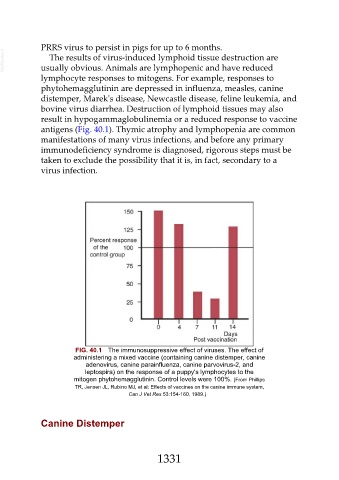Page 1331 - Veterinary Immunology, 10th Edition
P. 1331
PRRS virus to persist in pigs for up to 6 months.
VetBooks.ir usually obvious. Animals are lymphopenic and have reduced
The results of virus-induced lymphoid tissue destruction are
lymphocyte responses to mitogens. For example, responses to
phytohemagglutinin are depressed in influenza, measles, canine
distemper, Marek's disease, Newcastle disease, feline leukemia, and
bovine virus diarrhea. Destruction of lymphoid tissues may also
result in hypogammaglobulinemia or a reduced response to vaccine
antigens (Fig. 40.1). Thymic atrophy and lymphopenia are common
manifestations of many virus infections, and before any primary
immunodeficiency syndrome is diagnosed, rigorous steps must be
taken to exclude the possibility that it is, in fact, secondary to a
virus infection.
FIG. 40.1 The immunosuppressive effect of viruses. The effect of
administering a mixed vaccine (containing canine distemper, canine
adenovirus, canine parainfluenza, canine parvovirus-2, and
leptospira) on the response of a puppy's lymphocytes to the
mitogen phytohemagglutinin. Control levels were 100%. (From Phillips
TR, Jensen JL, Rubino MJ, et al: Effects of vaccines on the canine immune system,
Can J Vet Res 53:154-160, 1989.)
Canine Distemper
1331

